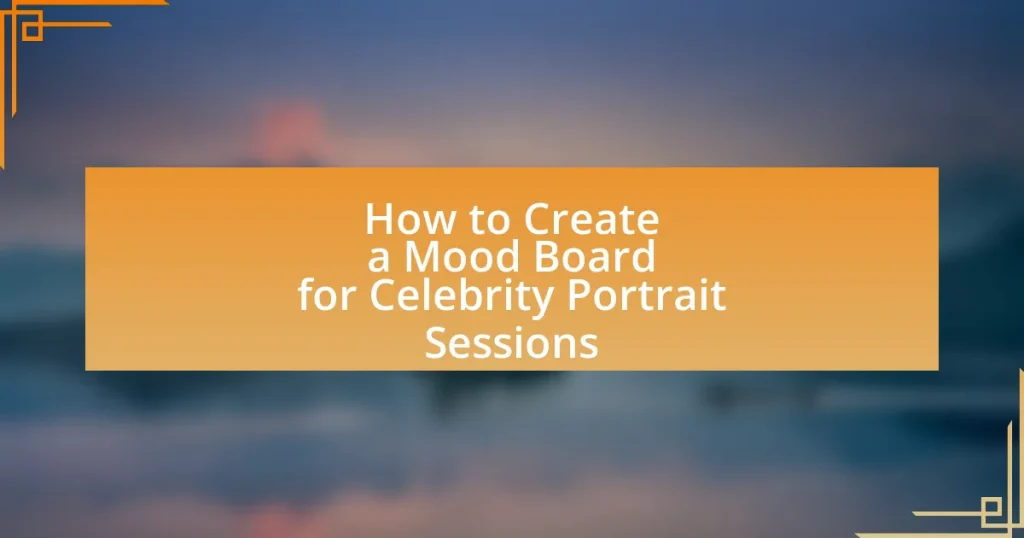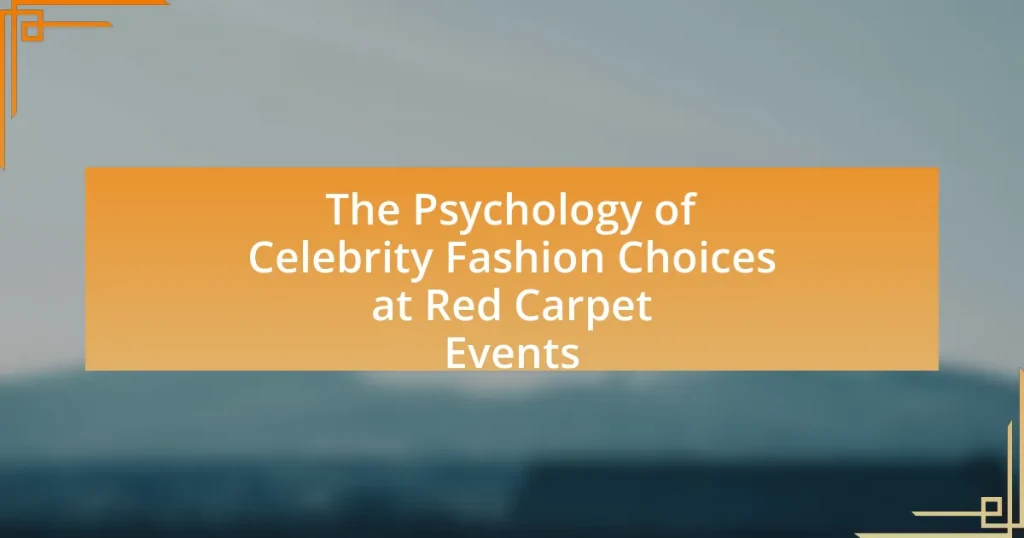A mood board for celebrity portrait sessions is a visual collage that encapsulates the desired aesthetic, themes, and emotions for a photo shoot, serving as a crucial reference for photographers and stylists. This article outlines the importance of mood boards in enhancing the creative process, detailing the elements typically included, such as images, color palettes, and textures. It also discusses how visual inspirations influence the final portrait outcome and provides practical steps for creating an effective mood board, including gathering inspiration and selecting images that align with a celebrity’s brand. Additionally, best practices for presenting mood boards to clients and common pitfalls to avoid are highlighted, emphasizing the significance of clear communication and alignment with client expectations.
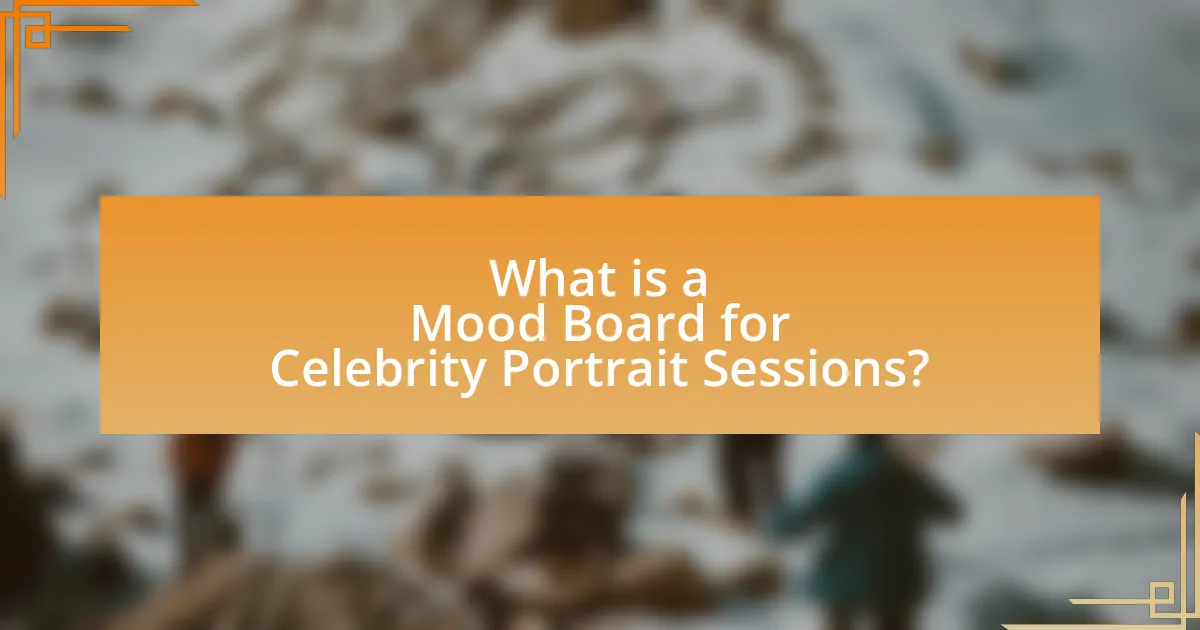
What is a Mood Board for Celebrity Portrait Sessions?
A mood board for celebrity portrait sessions is a visual collage that conveys the desired aesthetic, themes, and emotions for the photo shoot. It typically includes images, color palettes, textures, and other visual elements that inspire the creative direction of the session. Mood boards serve as a reference point for photographers and stylists, ensuring that everyone involved shares a unified vision. This practice is supported by the fact that visual storytelling is crucial in photography, as it helps to evoke specific feelings and narratives, making the final portraits more impactful.
How does a mood board enhance the creative process?
A mood board enhances the creative process by visually organizing ideas, themes, and inspirations, which facilitates clearer communication and direction in projects. By compiling images, colors, textures, and typography, a mood board serves as a reference point that aligns the creative vision among team members. Research indicates that visual stimuli can improve cognitive processing and memory retention, making it easier for creatives to conceptualize and execute their ideas effectively. This structured approach not only streamlines the brainstorming phase but also helps in maintaining focus throughout the project, ultimately leading to more cohesive and innovative outcomes.
What elements are typically included in a mood board?
A mood board typically includes images, color palettes, textures, typography, and inspirational quotes. Images serve as visual references that convey the desired aesthetic, while color palettes establish the overall mood and tone. Textures add depth and tactile quality, and typography reflects the style of communication. Inspirational quotes can encapsulate the theme or emotion intended for the project. These elements collectively help in visualizing concepts and guiding the creative process, making them essential for effective mood boards in various design contexts, including celebrity portrait sessions.
How do visual inspirations influence the final portrait outcome?
Visual inspirations significantly shape the final portrait outcome by providing a reference framework that guides artistic decisions. These inspirations can dictate elements such as color palettes, composition, and emotional tone, ultimately influencing how the subject is perceived. For instance, a mood board filled with images that evoke a specific atmosphere can lead to a portrait that captures the intended mood, as seen in the work of renowned photographers who often curate visual references to align their artistic vision with the final product. This method is supported by studies in visual perception, which indicate that artists who utilize visual references tend to produce work that resonates more effectively with their audience, enhancing the emotional impact of the portrait.
Why is a mood board important for celebrity portrait sessions?
A mood board is important for celebrity portrait sessions because it visually communicates the desired aesthetic and emotional tone of the shoot. By compiling images, colors, textures, and styles, the mood board serves as a reference point for the photographer, stylist, and the celebrity, ensuring that everyone involved shares a unified vision. This alignment enhances creativity and efficiency during the session, leading to more impactful and cohesive portraits. Studies in visual communication emphasize that mood boards can significantly improve collaboration and clarity in creative projects, making them a valuable tool in the context of celebrity photography.
How does it help in communicating ideas with the client?
Creating a mood board helps in communicating ideas with the client by visually representing concepts, themes, and styles that align with their vision. This visual tool allows clients to see a curated collection of images, colors, and textures, facilitating clearer discussions about preferences and expectations. Research indicates that visual aids enhance understanding and retention of information, making it easier for clients to articulate their desires and for creators to align their work with those expectations.
What role does it play in setting the tone and style of the shoot?
The mood board plays a crucial role in setting the tone and style of the shoot by visually conveying the desired aesthetic and emotional direction. It serves as a reference point for the photographer, stylist, and subjects, ensuring that everyone involved shares a unified vision. By incorporating specific colors, textures, and imagery, the mood board influences decisions on lighting, wardrobe, and poses, ultimately shaping the overall atmosphere of the portrait session. This alignment is essential for achieving a cohesive look that resonates with the intended message or theme of the shoot.
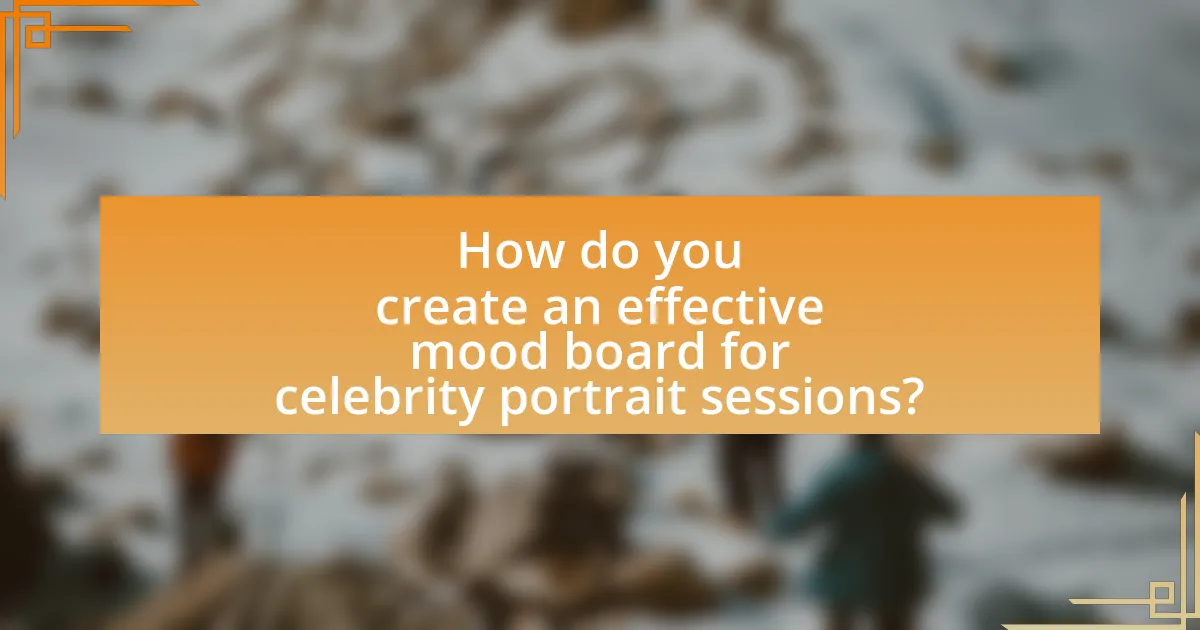
How do you create an effective mood board for celebrity portrait sessions?
To create an effective mood board for celebrity portrait sessions, start by gathering visual inspiration that reflects the desired style, mood, and theme of the shoot. This can include images from magazines, online platforms like Pinterest, or previous works that resonate with the intended aesthetic. Organize these visuals cohesively, ensuring they convey a clear narrative or emotion that aligns with the celebrity’s persona and the overall concept of the session. Research shows that mood boards enhance creative direction by providing a visual reference that can guide lighting, wardrobe, and poses, ultimately leading to a more focused and successful photoshoot.
What steps should be followed to gather inspiration?
To gather inspiration for creating a mood board for celebrity portrait sessions, follow these steps: first, identify the theme or concept you want to explore, as this will guide your selection of images and ideas. Next, research existing celebrity portraits and mood boards to understand current trends and styles, which can be found on platforms like Pinterest or Instagram. After that, collect a variety of visual elements such as colors, textures, and poses that resonate with your theme, ensuring they align with the mood you wish to convey. Finally, organize these elements into a cohesive layout that reflects your vision, allowing for adjustments as needed to enhance the overall aesthetic. This structured approach ensures that your mood board effectively communicates your creative direction.
Where can you find visual references for your mood board?
You can find visual references for your mood board on platforms like Pinterest, Unsplash, and Instagram. These platforms offer a vast array of images and inspiration tailored to various themes and styles, making them ideal for gathering visual elements for mood boards. For instance, Pinterest allows users to search for specific keywords related to celebrity portrait sessions, providing curated collections of images that can spark creativity and direction. Unsplash offers high-quality, royalty-free images that can be used to enhance the aesthetic of your mood board, while Instagram showcases real-time trends and styles through user-generated content, allowing for a contemporary perspective on visual references.
How do you select images that align with the celebrity’s brand?
To select images that align with a celebrity’s brand, one must analyze the celebrity’s public persona, values, and target audience. This involves reviewing their previous work, social media presence, and any brand partnerships to ensure consistency in visual representation. For instance, if a celebrity is known for a glamorous lifestyle, images that reflect luxury, elegance, and sophistication should be prioritized. Research indicates that visual consistency can enhance brand recognition, with studies showing that cohesive imagery can increase audience engagement by up to 30%. Therefore, selecting images that resonate with the celebrity’s established brand identity is crucial for effective mood board creation.
What tools and software can be used to create a mood board?
Tools and software that can be used to create a mood board include Adobe Photoshop, Canva, Milanote, and Pinterest. Adobe Photoshop offers advanced editing features for detailed mood boards, while Canva provides user-friendly templates for quick designs. Milanote allows for visual organization of ideas and inspiration, making it ideal for creative projects. Pinterest serves as a platform for gathering and curating visual inspiration from various sources. These tools are widely recognized in the design community for their effectiveness in mood board creation.
Which digital platforms are best for designing mood boards?
Canva, Pinterest, and Adobe Spark are the best digital platforms for designing mood boards. Canva offers a user-friendly interface with customizable templates, making it easy to create visually appealing boards. Pinterest serves as a vast source of inspiration, allowing users to collect and organize images from various sources. Adobe Spark provides advanced design features and integration with other Adobe products, catering to users seeking more professional results. These platforms are widely recognized for their effectiveness in mood board creation, supported by their popularity among designers and creatives.
How can traditional methods enhance the mood board creation process?
Traditional methods enhance the mood board creation process by fostering tactile engagement and visual diversity. Utilizing physical materials such as magazines, fabric swatches, and color samples allows creators to explore textures and colors in a way that digital tools cannot replicate. This hands-on approach encourages spontaneous creativity and can lead to unique combinations that inspire innovative ideas. Studies in design psychology indicate that tactile experiences can stimulate creativity and enhance memory retention, making traditional methods a valuable asset in the mood board development process.
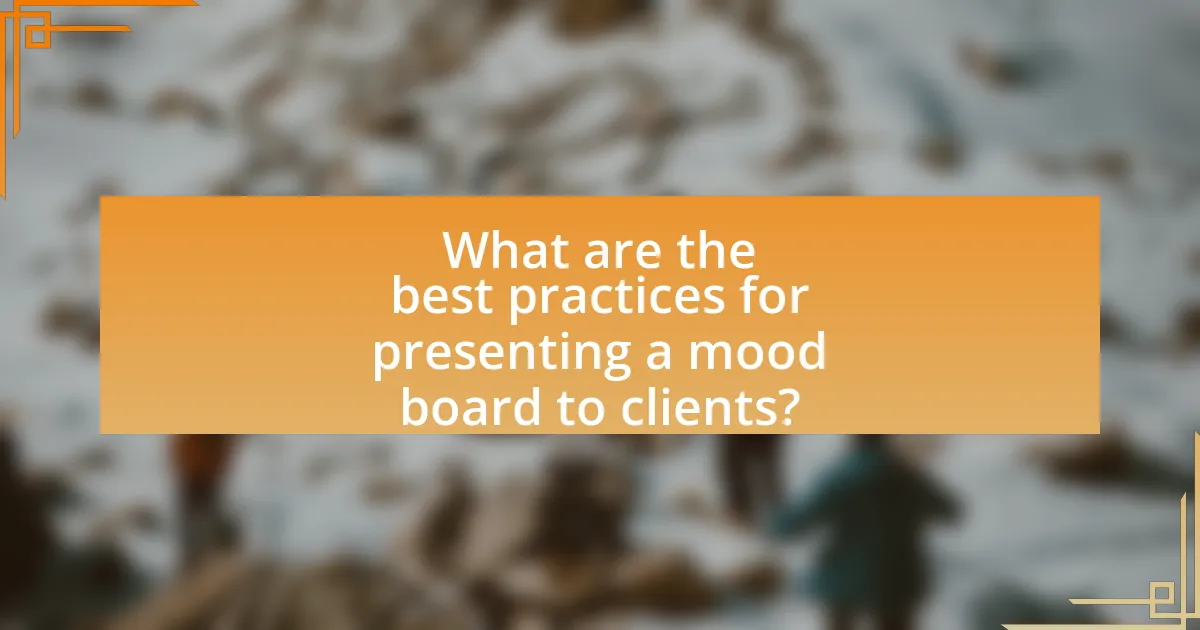
What are the best practices for presenting a mood board to clients?
The best practices for presenting a mood board to clients include clearly articulating the vision, ensuring visual coherence, and engaging the client in the discussion. Presenting the vision involves explaining the concept behind the mood board, which helps clients understand the intended direction. Visual coherence is achieved by selecting images, colors, and textures that align with the overall theme, making it easier for clients to grasp the aesthetic. Engaging clients in the discussion allows for feedback and adjustments, fostering collaboration and ensuring that the final outcome aligns with their expectations. These practices enhance communication and improve client satisfaction, as evidenced by studies showing that collaborative processes lead to better project outcomes in creative fields.
How should you structure your presentation for maximum impact?
To structure your presentation for maximum impact, begin with a clear introduction that outlines the purpose and key points. Follow this with a logical flow of content, dividing it into sections that cover each aspect of creating a mood board for celebrity portrait sessions, such as inspiration sources, color schemes, and layout techniques. Use visuals effectively to complement your points, ensuring they are relevant and engaging. Conclude with a strong summary that reinforces the main takeaways. Research indicates that presentations with a clear structure and visual aids can enhance audience retention by up to 65%, making this approach effective for impactful communication.
What key points should you highlight during the presentation?
Highlight the purpose of the mood board, which is to visually communicate the desired aesthetic and emotional tone for celebrity portrait sessions. Emphasize the importance of selecting images that reflect the intended style, color palette, and themes relevant to the celebrity’s persona. Discuss the need for collaboration with the celebrity and their team to ensure alignment with their vision. Additionally, mention the significance of including reference materials, such as textures and lighting examples, to guide the photography process. These points are essential for creating an effective mood board that enhances the overall portrait session experience.
How can you encourage client feedback on the mood board?
To encourage client feedback on the mood board, actively engage clients by asking specific questions about their preferences and interpretations of the visuals presented. This approach fosters a collaborative atmosphere, making clients feel valued and involved in the creative process. Research indicates that client involvement enhances satisfaction and leads to better project outcomes, as seen in studies on collaborative design practices. By prompting clients to express their thoughts on color schemes, styles, and overall themes, you create opportunities for constructive dialogue that can refine the mood board to better align with their vision.
What common mistakes should be avoided when creating a mood board?
Common mistakes to avoid when creating a mood board include lack of focus, excessive clutter, and neglecting the target audience. A mood board should have a clear theme or concept to effectively convey the intended message; without focus, the board can become confusing and ineffective. Excessive clutter, such as too many images or elements, can overwhelm viewers and dilute the core idea. Additionally, failing to consider the target audience can lead to a disconnect between the mood board and the intended emotional response, making it less impactful. These mistakes can hinder the overall effectiveness of the mood board in guiding the creative process for celebrity portrait sessions.
How can overloading the mood board with images detract from its purpose?
Overloading a mood board with images can detract from its purpose by overwhelming the viewer and obscuring the intended message. When a mood board contains too many images, it becomes cluttered, making it difficult for the audience to focus on key themes or concepts. Research indicates that cognitive overload can impair decision-making and creativity, as individuals struggle to process excessive information (Sweller, 1988). Therefore, a well-curated selection of images is essential to effectively communicate the desired aesthetic and emotional tone for celebrity portrait sessions.
What are the risks of not aligning the mood board with the client’s vision?
Not aligning the mood board with the client’s vision can lead to significant risks, including client dissatisfaction and project delays. When the mood board does not reflect the client’s expectations, it can result in a final product that fails to resonate with the client’s brand or personal style, leading to negative feedback and potential loss of future business. Additionally, misalignment can cause rework, which extends timelines and increases costs, as revisions may be necessary to meet the client’s vision. According to a study by the Project Management Institute, 70% of projects fail due to poor communication and misalignment of goals, highlighting the importance of ensuring that creative outputs align with client expectations.
What tips can help you refine your mood board creation process?
To refine your mood board creation process, focus on selecting a cohesive theme that aligns with your vision for the celebrity portrait session. This involves curating images, colors, and textures that resonate with the desired mood and style, ensuring that all elements work harmoniously together. Research indicates that a well-defined theme enhances creativity and clarity in visual projects, as supported by studies on design psychology which show that thematic consistency improves viewer engagement and understanding.
